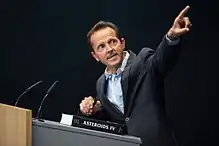Patrick Michel
Patrick Michel (born 25 February 1970 in Saint-Tropez, France) is a French planetary scientist, Senior Researcher at CNRS (Centre National de la Recherche Scientifique), leader of the team TOP (Theories and Observations in Planetology) of the Lagrange Laboratory at the Côte d'Azur Observatory in Nice (France).

Career
Michel began his advanced education with a degree in Aeronautical Engineering and Space Techniques in 1993 whereafter he moved to the study of asteroids. He received his PhD in 1997 for a thesis titled "Dynamical evolution of Near-Earth Asteroids". He is specialist of the physical properties and the collisional and dynamical evolution of asteroids. His researches focus on the collisional processes between asteroids, the origin of near-Earth objects, binary asteroids, their physical properties, their response to various processes (impacts, tidal encounters, shaking) as a function of their internal and surface properties, and the risks of impacts with the Earth. His results have been the subject of more than 70 publications in refereed international journals, and have been featured on the covers of both Science[1] and Nature.[2]
Michel is deeply involved in several space missions and projects devoted to the investigation of small bodies and asteroid hazard. He is leading the European science team of the AIDA space mission technology demonstration, in collaboration between ESA and NASA, aimed at deflecting the secondary of the binary near-Earth asteroid Dydimos using a kinetic impactor. AIDA will go into Phase A study at ESA and NASA in February 2015. He is a co-I on the JAXA Hayabusa2 and NASA OSIRIS-REx sample return missions to a primitive near-Earth asteroid. Hayabusa2 was launched successfully on December 3rd, 2014 and OSIRIS-REx will be launched in September 2016. He was a co-chair of the science study team of the MarcoPolo-R sample return mission during the assessment study phase (2011-2013) at the European Space Agency (ESA). He belongs to the Near-Earth Object Mission Advisory Panel (NEOMAP) mandated by ESA to recommend space missions devoted to a better understanding of the impact threat. He is also responsible of the Work Package on numerical simulations of collisions and asteroid deflection by a kinetic impactor in the European Consortium NEOShield funded by the FP7 program of the European Commission (2012-2015).
He has wide involvement in international organizations and belongs to the Science Program Committee of CNES (French space agency). He has been elected Secretary of the Division 3 (Planetary Science) of the International Astronomical Union (IAU) in 2009-2012. He also belongs to the Action Team 14 (AT4) of the COPUOS at the United Nations aimed at recommending actions and an international organization to deal with the asteroid impact threat and to the Steering Committee of the International Asteroid Warning Network (IAWN) recommended by AT14.
In 2006 he received the "Young Researcher" prize from the French Society of Astronomy and Astrophysics. In 2012, he was awarded the Carl Sagan Medal from the American Astronomical Society,[3] and in 2013 he was awarded the International Prize Paolo Farinella in Planetary Science in recognition of his work on the collisional process. He actively contributes to public outreach and is regularly solicited by various media to participate in French TV shows, radio interviews, and to contribute to the writing of papers in popular journals on topics related to small celestial body hazards, space missions and planetary formation.
Asteroid 7561 PatrickMichel was named in his honor by the IAU.
References
- Michel, P., Benz, W., Tanga, P., Richardson, D.C. 2001. Collisions and Gravitational Reaccumulation: Forming Asteroid Families and Satellites. Science 294, 1696-1700.
- Michel, P., Benz, W., Richardson, D.C. 2003. Fragmented parent bodies as the origin of asteroid families. Nature 421, 608-611.
- "Carl Sagan Medal for Excellence in Public Communication in Planetary Science". American Astronomical Society. Retrieved 4 December 2013.
External links
- (in French) Patrick Michel's Home Page
- (in French) TOP Team
- (in English) NEOMAP Committee
- (in French) Patrick Michel, astrophysicien (audio), Ciel et Espace radio podcasts, un métier, une passion, Patrick Michel